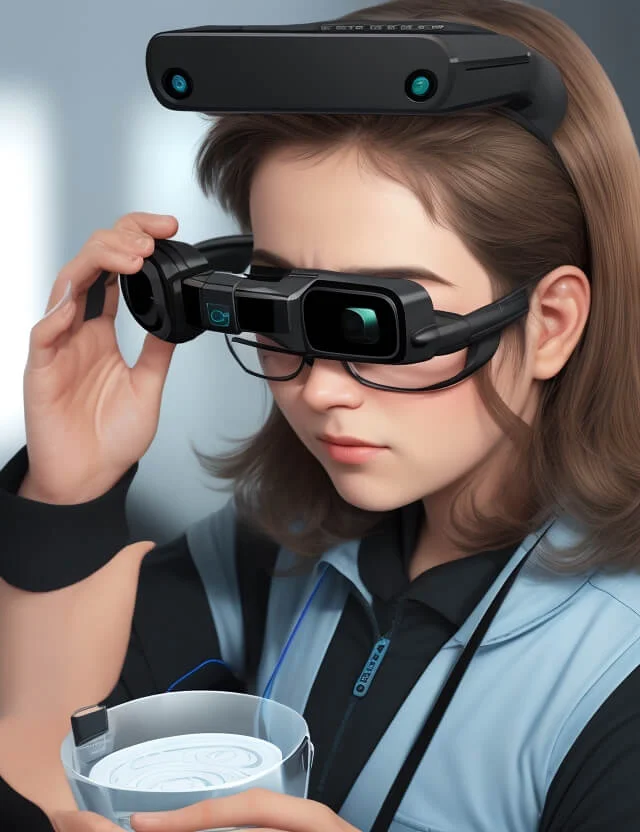Discover Advanced Assistive Tools for People With Visual Problems
The landscape of assistive innovation for people with visual problems is evolving quickly, presenting an array of ingenious tools that enhance freedom and interaction. From smart glasses that flawlessly combine visual input with acoustic assistance to advanced navigating applications that redefine spatial recognition, these devices are improving opportunities.
Smart Glasses Innovations
Smart glasses stand for a substantial innovation in assistive technology for people with aesthetic problems. These innovative tools incorporate various attributes designed to enhance the user's communication with their environment. Equipped with sensing units and cameras, smart glasses can record real-time visual details, which is then processed and communicated to the individual with sound comments or haptic feelings. This capability permits people to get prompt summaries of their environments, enhancing their capacity to browse and engage with the world.
Furthermore, developments in synthetic knowledge have better boosted the capacities of smart glasses. Maker knowing formulas can recognize faces, checked out message, and determine things, making them important devices for day-to-day jobs. Individuals can receive acoustic signs that supply context about their setting, fostering freedom and self-confidence.
In addition, the ergonomic style and light-weight nature of many wise glasses make them ideal for prolonged usage, guaranteeing convenience while boosting performance. As these tools continue to progress, they hold the potential to reinvent the way individuals with aesthetic problems experience their everyday lives, connecting the void between access and technology. The ongoing r & d in this area pledge to increase the possibilities for smart glasses, making them an essential element of contemporary assistive devices.
Navigation Application and Devices
Various navigation applications and devices have actually become necessary sources for individuals with aesthetic problems, significantly improving their capacity to go across unfamiliar environments. These modern technologies take advantage of general practitioner functionality, audio hints, and real-time data to supply customers with accurate navigating aid.
One prominent instance is the Aira application, which connects users to skilled representatives that can provide aesthetic descriptions of environments and navigating support via a real-time video clip feed. This service enhances the user's spatial understanding and self-confidence while browsing. One more significant tool is Seeing Eye GPS, which provides voice-guided navigating and sights, enabling users to access crucial details regarding their surroundings.

As innovation remains to development, the growth of a lot more sophisticated navigation devices assures to additional encourage individuals with visual problems, promoting smooth flexibility and combination into varied atmospheres. Such technologies are crucial in advertising a much more comprehensive society.
Braille Innovation Innovations
In the last few years, advancements in Braille technology have substantially transformed just how individuals with aesthetic disabilities gain access to information and engage with the globe around them. The advancement of mobile Braille screens has changed analysis by allowing individuals to link wirelessly to smartphones, computer systems, and tablets. These devices convert Web Site message into Braille in real-time, allowing seamless communication with digital web content.
Additionally, ingenious Braille printers have emerged, enhancing the manufacturing of responsive products. Modern embossers are faster and more efficient, enabling the fast production of Braille files and instructional products. This effectiveness reduces the moment and price connected with producing Braille resources, making them extra accessible to organizations and schools.
Furthermore, the assimilation of Braille with other modern technologies, such as artificial knowledge and artificial intelligence, has opened up new methods for personalized understanding experiences. Voice acknowledgment and synthesis technologies can enhance Braille, offering a comprehensive approach to details circulation.
As the demand for inclusive education and workplace atmospheres grows, these technical developments play a critical duty in equipping people with aesthetic impairments, guaranteeing they have equivalent access to information and possibilities in numerous aspects of life.
Wearable Instruments for Freedom
A growing array of wearable tools is boosting freedom for people with aesthetic disabilities, offering innovative solutions that improve navigation and day-to-day living. Braille displays and notetakers. These devices utilize innovative innovations to give real-time feedback and assistance, advertising freedom in different atmospheres

Wearable technology also includes smartwatches that can be configured with availability attributes, allowing individuals to receive alerts, track their locations, or perhaps call for aid with the touch of a switch. In addition, some gadgets integrate man-made intelligence to evaluate the setting, offering audio summaries of close-by things or people.
Voice-Activated Assistive Solutions
Leveraging voice-activated assistive solutions has changed the landscape of assistance for individuals with aesthetic problems, providing hands-free communication and access to a selection of jobs. These innovations make use of all-natural language handling and expert system to enable customers to execute everyday activities with simple voice commands.

Moreover, current innovations in voice recognition accuracy have actually boosted the customer experience dramatically, accommodating varied accents and speech patterns. This inclusivity ensures that more individuals can profit from these modern technologies, promoting a higher sense of freedom.
Conclusion
To conclude, the growth of innovative assistive devices significantly boosts the self-reliance and quality of life for individuals with aesthetic disabilities. Developments such as clever glasses, navigating applications, Braille innovation, wearable devices, and voice-activated services jointly promote an even more comprehensive atmosphere. These technologies encourage individuals to navigate their surroundings with self-confidence and engage even more completely with the world, inevitably promoting better accessibility and equivalent chances for people encountering visual challenges.
The landscape of assistive modern technology for individuals with visual problems is evolving rapidly, providing a range of innovative gadgets that boost autonomy and involvement.Smart glasses represent a substantial advancement in assistive innovation for people with visual disabilities. As these tools continue to progress, they hold the possible to reinvent the method individuals with visual problems experience their daily lives, bridging the space in between ease of access and modern technology.In recent years, improvements in Braille modern technology have significantly changed just how people with visual impairments access info and engage with the globe around them. These innovations encourage individuals to navigate their surroundings with confidence and involve even more totally with the world, inevitably advertising better access and equal chances for people encountering visual challenges.